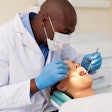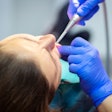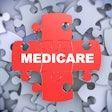
To the crowd of public health professionals who spend their days working to get oral health services to the underserved, the sound of high-ranking federal officials expounding upon the importance of getting poor kids into dental chairs was a reason to cheer.
Declaring "oral health is integral to overall health," Howard Koh, M.D., M.P.H., assistant secretary for health for the U.S. Department of Health and Human Services (HHS), this week unveiled the HHS Oral Health Initiative 2010, designed to get preventive care to Medicaid and Head Start children, strengthen the dental workforce, and increase oral health research and public awareness in the U.S.
"We want to work with you to build a sense of health security and, most importantly, to build a true system of care," said Dr. Koh, speaking at the National Oral Health Conference, held April 26-28 in St. Louis. Dr. Koh, joined by other HHS leaders, linked shortages of preventive dental care to wider gaps in the nation's healthcare system that the Obama administration has set out to address with healthcare reform.
"So far we have had a sick-care system, fragmented and focused on treatment, often delivered too late. We now need a system of care and prevention delivered as soon as possible," said Dr. Koh, a former Massachusetts state public health commissioner and associate dean at the Harvard School of Public Health who took over the job at HHS 10 months ago. "With this initiative, we plan to improve oral health by removing barriers to care."
Overcoming barriers to care
Those barriers were deeply familiar to the public health dentists, hygienists, administrators, and advocates gathered for the conference. Poverty, geographical and economic isolation, a lack of awareness of the importance of oral health, and a lack of dental benefits all complicate the work of delivering care.
According to federal statistics, about 108 million people in the U.S. currently have no dental insurance. And even those who are covered may have trouble getting care.
— Cindy Mann, Centers for Medicare
and Medicaid Services
Garth Graham, M.D., M.P.H., deputy assistant secretary for minority health at the HHS, said the U.S. government has no official estimate of the total number of Americans expected to gain dental coverage as a result of the healthcare reform act signed into law earlier this year.
The Pew Children's Dental Campaign estimates that at least 5.3 million currently uninsured children will receive benefits through Medicaid, the Children's Health Insurance Program, and health insurance exchanges. The healthcare reform act does less to directly address the lack of dental care for poor adults.
But it does authorize funds for expanding federally qualified health centers and to encourage workforce innovations and training designed to help make additional services available, Dr. Graham said.
Currently, the sheer lack of dental providers in many areas makes care hard to find. The U.S. has about 141,800 working dentists and 174,100 dental hygienists, but 4,230 federally designated dental health professional shortage areas.
"Forty-nine million people live in those areas," said Mary Wakefield, Ph.D., R.N., administrator of the Health Resources and Services Administration, who is leading the oral health initiative along with Dr. Koh.
Dental providers who treat children and accept Medicaid are in particularly short supply.
"While all children enrolled in Medicaid and CHIP (the state Children's Health Insurance Program) have dental coverage now, many children enrolled in those programs do not in fact have access to good oral health," said Cindy Mann, J.D., director of the Center for Medicaid and State Operations at the Centers for Medicare and Medicaid Services. "Nationwide, our data show that only a little more than a third of the children enrolled in Medicaid are receiving the dental care that they require. This is, frankly not acceptable."
Mann announced a goal of getting 10% more Medicaid and CHIP children in for preventive dental care "in each state and nationally over five years." She also pledged to boost the number of children receiving dental sealants by 10% over five years.
"We are serious about these goals, and we will plan to measure and report on the progress that we make," Mann said. Successful approaches are already in use in some states, she said. These include allowing dental hygienists and other midlevel dental providers to provide community-based preventive services for children, and allowing pediatricians and primary care doctors to provide fluoride varnish to children at high risk for tooth decay.
Another branch of HHS, the Administration for Children and Families, has been tasked with securing dental homes for Head Start children and with educating Head Start staff and parents about the importance of oral health. As described, the plan will use a public-private partnership to develop a national infrastructure focused upon recruiting and retaining dentists to provide dental homes for young high-risk children.
Other new federal initiatives related to oral healthcare include the following:
- The Centers for Disease Control and Prevention and the National Institutes of Health (NIH) are working together to develop a first-ever comprehensive National Oral Health Surveillance Plan that would monitor oral diseases, conditions, and oral health-related behaviors in the U.S. population.
- The Indian Health Service will expand its Early Childhood Caries Initiative through interdisciplinary efforts to reduce decay including early childhood assessments by partners such as Head Start and the Special Supplemental Nutrition Program for Women, Infants, and Children (WIC).
- The Office of Minority Health will develop online cultural competency training modules for oral health clinical providers.
- The Office on Women's Health will incorporate enhanced oral health messages in its websites, products, and campaigns.
- And the NIH National Center for Research Resources will fund the development of a Web-accessible clinical research toolkit for researchers to facilitate the standardization of dental research and a national dental research consortium infrastructure.
Making it work
To many at the conference, the attention of the U.S. government to oral health disparities and the news of the federal oral health initiative were very encouraging signs.
"I am thrilled the administration is focused on two things near and dear to our hearts: coverage and access to Medicaid kids and sealants," said Shelly Gehshan, director of the Pew Children's Dental Campaign.
"To me," said Dr. Man Wai Ng, chief of the department of dentistry at Children's Hospital Boston, the initiative constitutes "a renewal of resources and commitment."
Dr. Harry S. Goodman, director of Maryland's Office of Oral Health, agreed. "It's incredibly exciting." He said he hopes the plan lives up to its potential on the state and local levels. "The trick is to get it all coordinated."
Copyright © 2010 DrBicuspid.com



















